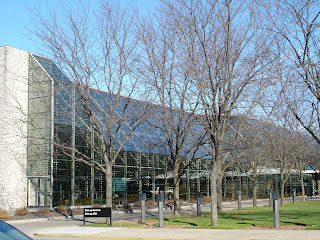Thursday November 12 2009
How did Columbus IN, located pretty much in the middle of nowhere, become a hotbed of 20th century architecture? It's one of those stories that makes you believe that all history is accident. In the late 1930's a new church was scheduled to be built in Columbus, but the scheduled architect died. So J. Irwin Miller, Columbus's major businessman known locally as a "Renaissance Man," then hired Eliel Saarinen to design the First Christian Church, completed in 1942 (see above). It was the first "modern" church in the state and one of the first in the U.S. Miller became a real fan of the Saarinens and their Cranbrook School, but it was not until 15 years later that his vast public investment in contemporary architecture took off.
In the mid-1950's, he offered to pay the architectural fees for any school building built in the town, and once that got under way, he did the same for libraries, fire stations, and other municipal buildings. Eventually, other businessmen took his lead and also hired world-famous architects. Most of the architects are disciples of Saarinen, but a few others snuck by, such as Robert Venturi, who designed Fire Station #4 (see below).

My friends George and Alice Wislocki had a house built by Venturi on the Vineyard and are longtime Venturi fans. So I made a special trip out to the fire station to take a picture of it for them.
Roche Dinkeloo seem to be the most favored architects of late, as evidenced by Cummins headquarters

across the street from Irwin Bank
and also across the street from a new post office.
These three buildings face one another on Jackson, just off Washington, the main drag in Columbus.
One of the buildings I particularly liked is another Irwin Bank, this one designed by Harry Weese, who
designed more buildings in Columbus than any other architect. It's a clean-looking structure, and quite striking. Until you notice where you are, which is at one end of a mind-bogglingly depressing strip mall that's largely deserted for obvious reasons. When you turn your back to the bank, here's what you see:
and this
This contrast between the beautiful and the banal, between real architecture and strip malls full of franchises, is all over town. I don't know why I thought that I'd drive into Columbus and be struck dumb by beautiful building after beautiful building. That's just not how it is here. Downtown there are perhaps a dozen serious buildings, and the rest of the architectural gems are scattered widely throughout the city. But then, of course, it would have to be that way since Miller started out by paying architectural fees for public schools and then branched out into other municipal buildings. Which, quite obviously, aren't smack dab up against one another.
Tomorrow I'm taking the two-hour tour so I can write more knowledgeably about this later. In the meantime, another anecdote about the 5000 people in the world we all know. I picked up a map put out by the visitors' bureau of all the important buildings and sculpture, and as I was browsing through it, I saw that the Cummins headquarters features a huge metal sculpture by Rudolph de Harak, stepfather of Jon Sylbert, a long-time Monterey select board member and Monterey Land Trust president. Rudy's widow Carol now lives in Monterey around the corner from Jon and his family. Here's the sculpture, "Exploded Engine":
One last photo of the day to prove that I'm not the worst car parker in America.









Fire station #4 is a hoot. Who whould have thought R Venturi would have lit there for a commission. I only makes me pine for the same to have happened in you know what neighboring town to Monterey.
ReplyDeleteDream on my friend, dream on. Laury
ReplyDeleteKeep that sense of humor!
ReplyDelete